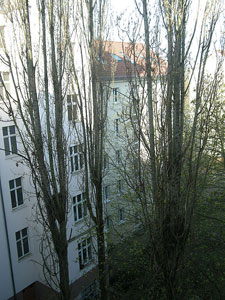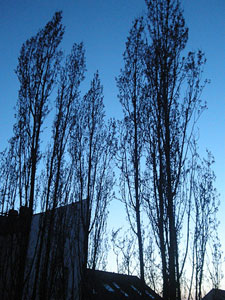I really enjoyed reading Julie Rafalski’s last blog on the flagship site, Henningham Family Press. I liked how just one overheard word on the tube led to such a flow of information. The whole subject of how one writes or composes was foremost in my head yesterday as I tottered along Invalidenstrasse on a beautifully warm spring afternoon in Berlin. I’d just got back from a hectic schedule of visiting family in Edinburgh and Accrington which had laid me up in bed for two days with a virus on my return. The 48 hour wipe-out had cleared my head enabling me to think about what I would write about in this month’s blog. And I realised for the first time that when I write anything I always start with a solid picture in my head which I then describe; so really the story already exists, I am just noting it down.
Berlin has changed so much in the few days I have been in the UK. The remaining snow, ice and grit has gone and the concrete grey sky of nearly four months has given way to the blue of Giotto’s Padua frescos. On Wednesday morning I sat at the kitchen table looking out at this blue and the 3 Poplar trees standing tall in the Backhof. Accompanied by cacophonous birdsong and drinking the first coffee of the day I leafed through a book I’d bought up a couple of weeks earlier.
The World I Live In is Helen Keller’s second book, she wrote it in 1908 at the age of 28 some five years after her first book, The Story of My Life. At 19 months a mysterious illness had left her totally deaf and blind. Until the age of 7 she was cut off from the world, when a half blind teacher, Annie Sullivan joined her in Alabama and together they began an intensive course of learning. Helen Keller’s hunger to be in the world speeded her learning and by 1904, with the aid of Annie Sullivan, she had not only written her first book but had also completed a degree at Radcliffe College, Massachusetts.
In the first chapter of the book we are introduced to Helen Keller’s primary source of contact with the world, her hands; the right one to see with and the left one to read with. She puts forward a fascinating point for all sighted people to consider:
Physics tells me that I am well off in a world which, I am told, knows neither colour nor sound, but is made in terms of size, shape and inherent qualities; for at least every object appears to my fingers standing solidly right side up, and is not an inverted image on the retina which, I understand, your brain is at infinite though unconscious labour to set back on its feet. A tangible object passes complete into my brain with the warmth of life upon it, and occupies the same place that it does in space, without egotism, the mind is as large as the universe.
Some chapters on, there is a photo of Helen Keller; a young woman pressed against a tree in a wood. The caption reads; “listening” to the trees. Looking out at the 3 Poplars, I wonder what she might have heard from them?
I am not very good at judging heights but I live on the 4th floor and the trees shoot up with straight trunks high above the window. Due to the extensive bombing of Berlin in the later part of the second World War, and the extreme shortage of firewood following, I would guess that they are about 60 years old. They are impressive structures and provide a habitat for a variety of birds and wildlife including the odd red squirrel (or Eichhoernchen, a fine German name). Back in November their leaves withered away, naked and stoic they have waited out the harsh winter. In March things began to stir again and in the freezing cold mornings I sensed them at work, farming and distributing whatever nutrients they could find in the sleeping soil and absorbing anything they could from the pale daylight. It was as though with every sinew they where hauling up new life from roots to the furthest most isolated tips high above the roof tops. A couple of weeks ago new buds in muted tones of lizard green and cherry lips red began to show. I would predict that if the young lady was listening to these trees she would experience something akin to that of the straining trembling body of a power lifter, drawing and gathering strength for the final push. And perhaps the joyous almighty scream, that any day now will accompany the burst into bloom, will be big enough to throw her backwards onto the forest floor?
I heard an altogether different scream a day earlier when I reached the Hamburger Banhof – Museum fur Gegenwart. My walk in the sun had purposely led to the free admission afternoon of Berlin’s largest State collection of, Art since 1960. Of all the City’s Museums this one distresses me the most and not only because of the €12.50 entrance fee (the highest I know of in Berlin). The problem I have is with the automatic placing of work within a museum context, of many works which directly question their own positioning. The general feel of the place is of a curator’s/ DJ’s playground, resulting in acres of space (over 13000 sqm) strewn with large blocks of Joseph Beuys’s lard and broken bits of detritus from Fluxus performances. The most disturbing section is the never- ending Rieckhallen, the former Lehrter Banhof goods depot which now contains works from the Friedrich Christian Flick Collection. Here we find Gordon Matta- Clark and Robert Smithson, forever cutting up a house and running over a spiral jetty and yet another large Dieter Roth installation looking lost and abandoned. The check list of important names continues; Richard Artschwager, Marcel Broodthaers, Sol Le Witt, Rodney Graham and Duane Hanson. Actually Duane Hanson’s shopper at least seems to have made the decision to try and get out of there, although the hopeless expression on her face indicates just how far away from the exit she still is. A typically light and throw away gesture from Roman Signer of a hack-sawed spray paint can (Arbeits Platz.1999), is sealed off in a claustrophobic cell with a semi roped off entrance to make doubly sure no fun can escape.
Oh yes, and the screaming. This begins about halfway down the Rieckhallen close to work by Lawrence Weiner; a mildly defiant statement of his, under the circumstances reads, LEFT HERE – PUT HERE – FOR A LIMITED TIME (#426. 1976/2004). And a glass fronted case displays some of his collected publications, all mounted like butterflies. Walking on the screaming gets louder giving you a sense of being trapped in some conceptual madhouse. Before finally reaching the source of the yelling there is one last detour, as you enter one of Absalon’s completely white cell structures. In a very short life (he died at 28) Absalon made many of these odd live/work pods. His artistic career was developed through a steady stream of commissions and exhibitions encouraging the further design and building of these minimalist structures. So perhaps it is not too surprising to discover it is Absalon who is screaming. This we witness through a short film made in the year of his death, Bruits 1993. With hindsight the film is really disturbing and not only for its imbedded frustrated madness. One can’t help also seeing a jarring between the disciplined, reductive practice of the artist and the space that has been allotted and constructed by the gallery to show the film. I realise that there must be sound proofing concerns, but when considering that Bruits was made by such simple means; man in front of camera screaming for 3minutes and 28 seconds, then one has to question the chapel size box made to house it?
The third and final scream that I’d encountered in the last week was on the early morning return Ryanair flight to Berlin. I had managed to sit in an aisle seat with my right ear next to a very unhappy baby and my left positioned far too close to one of the cabins speakers. The combination of the child emptying its lungs and the continuous drivel of pre recorded advertising made Absalons efforts at screaming look very amateurish by comparison. The poor distressed child persisted through taxiing, takeoff and well into our journey and was evenly matched by the chirpy Irish and Scottish brogue belting out of the speaker. Perhaps after 45 minutes the child passed out only I can’t say I noticed because by then the soundscape had become one. As my 3.30am start that morning mercifully began to kick-in, I was still being assaulted by offers of smokeless cigarettes, exclusive perfumes, surprisingly bright Chardonnays and an excellent full bodied red. Screaming, screaming, screaming!
On the sedate S Bahn journey back into Alexander Platz I began to reappraised the baby’s screaming as that of an astute critic. Perhaps even one so young knew it was going to be subjected to an epic reading of a script written by the Fast Show’s Swiss Tony and had responded accordingly.
Did I really have all that in my head?



